WreckDiver1692
Registered
Introduction
I was reallllly close to spending about 10k on a Nikon Z6 (better video than Z7) with an external monitor (Atomos Ninja V) and Nauticam housing for both and Kraken Sports lights with a remote plus all the other arms and such needed. I changed my mind because I wanted some additional features in the camera before settling on such an expensive rig (4k60 recording, 4:2:2 10-bit internal and without cropping, better AF performance with N-LOG recording, etc.), and also because although I try to dive one day a month locally, it's not enough to justify spending that much on a new setup given other savings goals I have (house isn't going to buy itself, sadly).
Concordantly, I decided to buy a GoPro instead and make my own rig. A GoPro with ample lighting should take video of sufficient quality at a fraction of the price. To be clear, the goal is a video camera rig, not one for photos per se, because I believe photos miss out on the important aspects of motion that only video can really capture well -- just my personal preference though.
However, I have never used a video camera rig before, so I am going at this by first reading up on everyone's views on what they want in a rig. I've been watching youtube videos and reading articles on why rigs are designed the way they are to gain better insight as to what I would like to feature in my own rig. To that end, I have come up with some design goals:
Design goals
Current Ideas
GoPro Hero 7
I decided to go with a GoPro Hero 7 (not the new Hero 8 that will be released in a few days) because the Hero 7 still has a built-in Micro HDMI out port. With the Hero 8, you'll need a "Media Mod" attachment, and who knows if/when someone will make a waterproof housing for that. Also, since the changes from 7 to 8 were more minor than anything, it seemed easier to go with the 7 and just modify one of the many waterproof housings you can get for it.
Unsealed, flooded unit
Additionally, with the GoPro itself sealed in its housing, I need only then make sure the monitor and it's accompanying battery pack is sealed from the water, as opposed to having to seal the entire rig. This is important because things can start to get really complex if you have to seal a big unit while still requiring access inside that unit -- you need a whole manner of o-rings and clean seals. I really want this device to be as simple as possible to build and accessible to almost anyone without getting too fancy. Plus, I'm wary of feature creep in the early iterations -- instead of taking years to build something with thousands of features and complexities, I'd rather build something simple that works and go from there.
Start simple (simple is relative -- this is simple for me)
My current plan is to start with a relatively simple shape, such as a cube. I was going to have a local plastics supplier cut me squares of 3/8" acrylic to form a cube. On the inside there will be a dome affixed to the top and inside the dome a lift bladder. I'll probably run a tube with a hydration bladder bite valve (thanks @James79 for the hydration bladder valve idea) at the end so it can be filled, and a pressure release / dump valve at the top of the bladder extending through dome and the top of the cube.
The front of the cube would have a mount for a GoPro with an extended housing which has a micro HDMI cable sealed into it and ultimately running to the monitor.
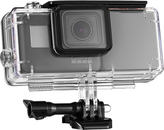
The rear of the cube would feature a 10" 2K monitor.
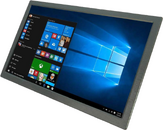
The plan is to get two clear acrylic sheets and sandwich the monitor between them, with the mini hdmi cable plugged in and the power cable as well and seal everything with silicone caulking. I'm not really worried about heating because it'll be submerged in water but we'll see. Also the silicone allows me to make changes if absolutely necessary (you can peel it away once dried) but otherwise provides a more or less permanent seal so that I don't need to worry about water getting in. These two sandwiched sheets of acrylic with the monitor in between would be the rear of the cube, attached to with a hinge used for a GoPro (the advantage being the hinges are waterproof and can have an infinite range of fixed positions, though I'll probably have to custom splice my own from some existing ones because I can't find any 90° ones).
The problem with a hinged setup (to allow the screen to be viewed at a range of angles) however is that it offsets the center of gravity of the device, so I was thinking of having some adjustable weights along a rail on the bottom of the device, near the front (because the very bottom center will have a tripod mount). I still have to think some more on this though.
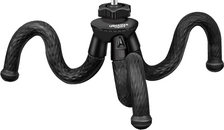
The other advantage of having a hinged design is that it would allow the user access to the inside of the device. I was thinking of having a tray at the bottom with just a stretchy net where objects could be placed if needed. Also, some pouches on the side and D-rings for attachments (though I personally wouldn't use them all that much because they'd offset the center of balance but they'd still be nice to have). Again, the goal is for the cube itself to be flooded so I don't have to worry about compression issues, with ample holes in key spots to allow water to flow in/out (so it doesn't weigh a ton when you try to take it out of the water)
The two wires coming out through the sealant of the sandwiched monitor screen (mini HDMI and 5v2a DC) would connect to the GoPro housing described above (it would be the same sealed wired) and a small housing for the 18650 battery pack. The wires themselves are coated in plastic so are fine getting wet, and everything else is already sealed. The battery housing needs to be sealed and reopened to change the batteries however, and I was going to do this simply by getting some plastic cups with fixed rubber inserts:
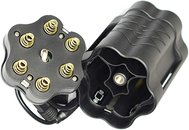
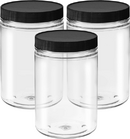
I am hoping this will be sufficient for a reliable seal but I'll have to test it. As for the cup's resilience under pressure I was planning on filling the cubs with epoxy/resin so that all but the battery compartment itself is solid.
As for balance and stability of the entire system, I'm going to add some weight to the bottom of the cube in the form of wheel weights, probably sealed in under a layer of resin to prevent corrosion. I'll attach handles with ball joints to the base of the cube in the center with appropriate-sized bolts and glue.
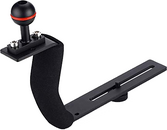
Things I'm still thinking through
Anyways, that is more or less what I have right now. If you have some suggestions or ideas please let me know. If anyone else is also interested in working on this as well, by all means let's collaborate. I just want to make a relatively inexpensive housing so more people can take great underwater video.
Cheers,
Nathan
I was reallllly close to spending about 10k on a Nikon Z6 (better video than Z7) with an external monitor (Atomos Ninja V) and Nauticam housing for both and Kraken Sports lights with a remote plus all the other arms and such needed. I changed my mind because I wanted some additional features in the camera before settling on such an expensive rig (4k60 recording, 4:2:2 10-bit internal and without cropping, better AF performance with N-LOG recording, etc.), and also because although I try to dive one day a month locally, it's not enough to justify spending that much on a new setup given other savings goals I have (house isn't going to buy itself, sadly).
Concordantly, I decided to buy a GoPro instead and make my own rig. A GoPro with ample lighting should take video of sufficient quality at a fraction of the price. To be clear, the goal is a video camera rig, not one for photos per se, because I believe photos miss out on the important aspects of motion that only video can really capture well -- just my personal preference though.
However, I have never used a video camera rig before, so I am going at this by first reading up on everyone's views on what they want in a rig. I've been watching youtube videos and reading articles on why rigs are designed the way they are to gain better insight as to what I would like to feature in my own rig. To that end, I have come up with some design goals:
Design goals
- System should be stable as it is pushed through the water because stable footage is critical to great video
- Should probably be more or less symmetrical
- Perhaps vertical/horizontal stabilizers could be used?
- Should probably be more or less symmetrical
- System should be neutrally buoyant because I heard from many sources that it's tiring fighting your camera rig when it is too buoyant or negative. Because buoyancy characteristics change at depth, it's important the system is adjustable.
- Having an internal lift bag would make it so it can be adjustable
- System should feature a large high resolution monitor so I can easily frame my shots
- It would be nice if the monitor is adjustable so that I could view it at a range of angles depending on where the rig is positioned
- A tiltable monitor could constructed with a simple hinge
- However, this would alter the center of balance, so I would ideally want some means to counterbalance the tilting of the monitor
- A tiltable monitor could constructed with a simple hinge
- It would be nice if the monitor is adjustable so that I could view it at a range of angles depending on where the rig is positioned
- System should actually cost me less in money/time than I would have spent simply buying the 10k setup and/or provide far greater value to the community (if other people are inspired to build this rig, share their cool videos, and spread a love of the ocean, that's a win in my book)
- Bonus: It would be nice if the system provided some utility beyond just being a camera housing
- If the lift capacity is high, it could double as a lift bag
- It could have pockets and D-rings to carry things
- Spare lights, emergency beacons, water, food
- If the lift capacity is high, it could double as a lift bag
Current Ideas
GoPro Hero 7
I decided to go with a GoPro Hero 7 (not the new Hero 8 that will be released in a few days) because the Hero 7 still has a built-in Micro HDMI out port. With the Hero 8, you'll need a "Media Mod" attachment, and who knows if/when someone will make a waterproof housing for that. Also, since the changes from 7 to 8 were more minor than anything, it seemed easier to go with the 7 and just modify one of the many waterproof housings you can get for it.
Unsealed, flooded unit
Additionally, with the GoPro itself sealed in its housing, I need only then make sure the monitor and it's accompanying battery pack is sealed from the water, as opposed to having to seal the entire rig. This is important because things can start to get really complex if you have to seal a big unit while still requiring access inside that unit -- you need a whole manner of o-rings and clean seals. I really want this device to be as simple as possible to build and accessible to almost anyone without getting too fancy. Plus, I'm wary of feature creep in the early iterations -- instead of taking years to build something with thousands of features and complexities, I'd rather build something simple that works and go from there.
Start simple (simple is relative -- this is simple for me)
My current plan is to start with a relatively simple shape, such as a cube. I was going to have a local plastics supplier cut me squares of 3/8" acrylic to form a cube. On the inside there will be a dome affixed to the top and inside the dome a lift bladder. I'll probably run a tube with a hydration bladder bite valve (thanks @James79 for the hydration bladder valve idea) at the end so it can be filled, and a pressure release / dump valve at the top of the bladder extending through dome and the top of the cube.
The front of the cube would have a mount for a GoPro with an extended housing which has a micro HDMI cable sealed into it and ultimately running to the monitor.

The rear of the cube would feature a 10" 2K monitor.

The plan is to get two clear acrylic sheets and sandwich the monitor between them, with the mini hdmi cable plugged in and the power cable as well and seal everything with silicone caulking. I'm not really worried about heating because it'll be submerged in water but we'll see. Also the silicone allows me to make changes if absolutely necessary (you can peel it away once dried) but otherwise provides a more or less permanent seal so that I don't need to worry about water getting in. These two sandwiched sheets of acrylic with the monitor in between would be the rear of the cube, attached to with a hinge used for a GoPro (the advantage being the hinges are waterproof and can have an infinite range of fixed positions, though I'll probably have to custom splice my own from some existing ones because I can't find any 90° ones).
The problem with a hinged setup (to allow the screen to be viewed at a range of angles) however is that it offsets the center of gravity of the device, so I was thinking of having some adjustable weights along a rail on the bottom of the device, near the front (because the very bottom center will have a tripod mount). I still have to think some more on this though.

The other advantage of having a hinged design is that it would allow the user access to the inside of the device. I was thinking of having a tray at the bottom with just a stretchy net where objects could be placed if needed. Also, some pouches on the side and D-rings for attachments (though I personally wouldn't use them all that much because they'd offset the center of balance but they'd still be nice to have). Again, the goal is for the cube itself to be flooded so I don't have to worry about compression issues, with ample holes in key spots to allow water to flow in/out (so it doesn't weigh a ton when you try to take it out of the water)
The two wires coming out through the sealant of the sandwiched monitor screen (mini HDMI and 5v2a DC) would connect to the GoPro housing described above (it would be the same sealed wired) and a small housing for the 18650 battery pack. The wires themselves are coated in plastic so are fine getting wet, and everything else is already sealed. The battery housing needs to be sealed and reopened to change the batteries however, and I was going to do this simply by getting some plastic cups with fixed rubber inserts:


I am hoping this will be sufficient for a reliable seal but I'll have to test it. As for the cup's resilience under pressure I was planning on filling the cubs with epoxy/resin so that all but the battery compartment itself is solid.
As for balance and stability of the entire system, I'm going to add some weight to the bottom of the cube in the form of wheel weights, probably sealed in under a layer of resin to prevent corrosion. I'll attach handles with ball joints to the base of the cube in the center with appropriate-sized bolts and glue.

Things I'm still thinking through
- Is having a flat cube face as the front going to cause issues with stability? Should it be a dome instead (even one that actually doesn't do anything because the camera will be outside of it
- Are other shapes better? I considered a sort of polygonal diamond shape but I need the device to remain relatively small as the camera will still need to be operated by hand
- How to counter-balance the fact that the screen can be positioned at many angles
- The monitor needs to be able to be accessed to press the 'on' button; I was going to cut off a little corner of the acrylic "sandwich" on one side where the on button is and then have that be a sealed thin plastic corner so the button is accessible. Maybe there are better solutions?
Anyways, that is more or less what I have right now. If you have some suggestions or ideas please let me know. If anyone else is also interested in working on this as well, by all means let's collaborate. I just want to make a relatively inexpensive housing so more people can take great underwater video.
Cheers,
Nathan



